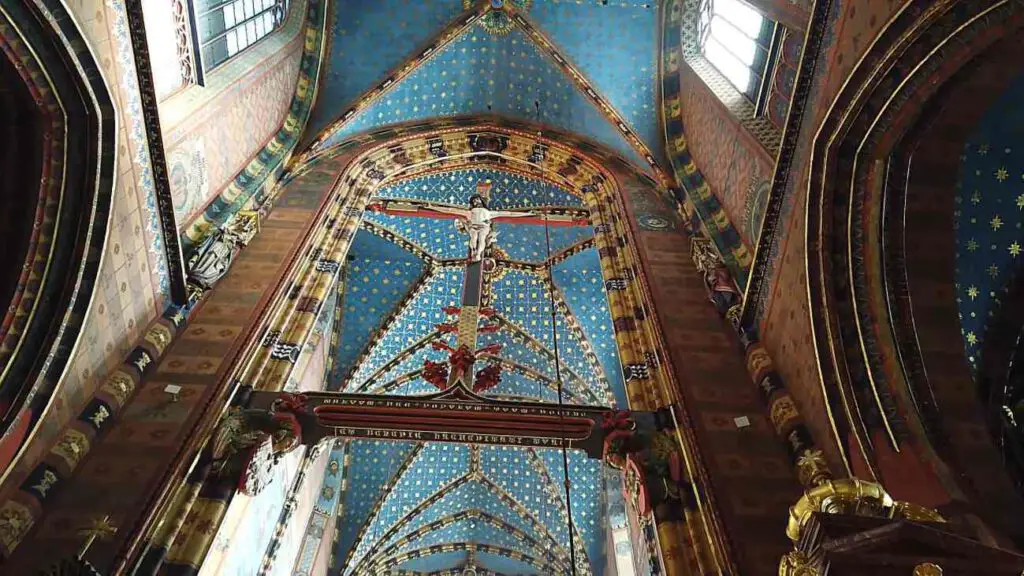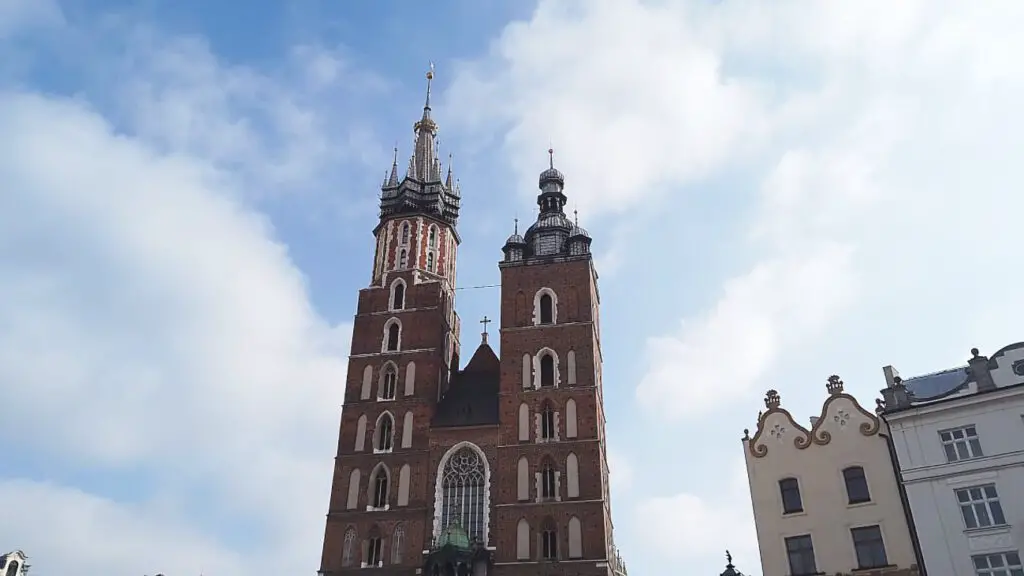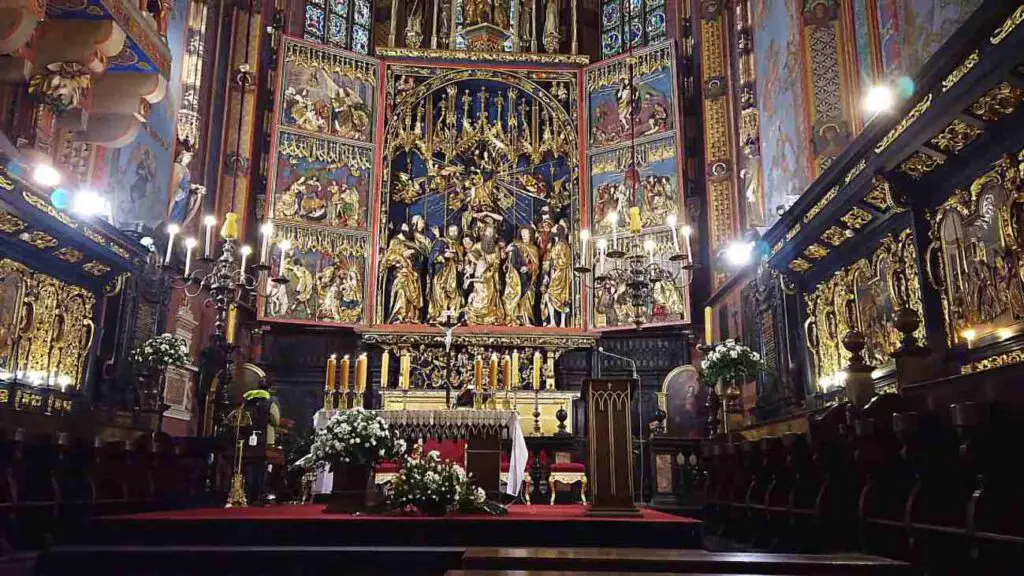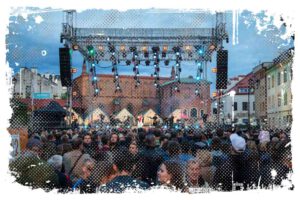If you ever find yourself wandering in the charming streets of Krakow, St. Mary’s Basilica would be a sight you can’t miss. St. Mary’s Church, considered to be second in importance only to the Wawel Cathedral, stands proudly as a testament to the rich history of this city.

Its construction traces back to the late 13th century. It replaced older Romanesque-style religious buildings but the modern basilica you see today underwent many makeovers through centuries. I am convinced that this historical monument is one of the city’s crown jewels.
Nestled cozily in the Old Town at Plac Mariacki 5, close to the Cloth Hall, the basilica’s official name is the Archpresbyterian Church of the Assumption of the Blessed Virgin Mary. This Gothic-style basilica’s look today is a reflection of the countless renovations it saw in the initial centuries of its existence.

Let me say, Jan Długosz believed that Iwo Odrowąż, the bishop of Kraków, founded the original church. Through time, the basilica saw various additions, including a presbytery, expansive windows, colorful stained glass, side chapels, and its distinctive two towers. I think the remarkable Great Altar of Wit Stwosz deserves special mention here, added to the basilica in the late 15th century.
↳ Make sure to read my guide to the most amazing places to stay in Kraków:
How to Find Best Place to Stay in Krakow Old Town – Your Guide
The Unmissable Artistry of St. Mary’s Church
When discussing St. Mary’s Church, we must delve into the magnificent altar by Veit Stwosz. Completed in 1489, this late Gothic masterpiece is an incredible specimen of skilled craftsmanship. It was made using not one but three types of wood. Strong oak provides the framework, the lighter larch wood forms the backdrop, and the soft linden wood turned out to be the perfect material for crafting the intricate figures.
The altarpiece showcases five wings, with each wing sporting complex bas-reliefs, including two pairs of movable and immobile elements.
The Tower, the Bugle, and the Chapels
If you’re feeling adventurous and up for a mini workout, climb the 239 stairs to reach the top of the tower. This is where the traditional bugle call is played. The first bugle call dates back to February 13, 1838, and was played precisely at noon. Back then, it was a source of information and a measure of time, making Krakow one of the few cities that publicly announced the time.

The basilica houses an impressive number of chapels – eleven to be exact. These days, a small fee is required for a visit, and the funds collected are utilized for the building’s maintenance and upkeep. If you want a bit of trivia, you’d be surprised to know that St. Mary’s Square was once a cemetery in the 18th century. And some of the tombstones from that era found their way into the building’s walls. This makes your visit to the basilica not only a spiritual journey but also a fascinating voyage through time.
Mysteries of St. Mary’s Basilica in Krakow
Being there, you need to know that the rich character of the church’s interior owes a lot to Jan Matejko. This eminent painter was deeply involved in the church’s renovation during 1890-1892. As you gaze at the breathtaking polychrome by Matejko, you can’t help but be overpowered by the riot of colors and shapes.

I believe Matejko was fully aware of the importance of his task. Apart from its aesthetic beauty, he managed to infuse his work with significant liturgical content, giving the church a distinct persona. This provoked mixed reactions among his contemporaries. Now, when you walk into the church, the grandeur of the decorations on the walls and facades will undeniably leave you in awe.
Here is a table with historic data about St. Mary’s Basilica in Krakow:
| Year | Event |
|---|---|
| Early 13th century | Foundations of the church were laid |
| 1221-22 | The Bishop of Krakow, Iwo Odrowąż, founded the first parish church at the site |
| 1290-1300 | The new early Gothic church was built on the site after the original building was destroyed during the Mongol invasion of Poland |
| 1347 | The church was completed |
| 1477-89 | The wooden altarpiece carved by Veit Stoss was installed |
| 1497 | The main section of the church was built |
| 1978 | The church was inscribed as a UNESCO World Heritage Site |
The Taller Tower – A Tale of Ownership
We all marvel at the Wit Stwosz altar, the bugle call, and yes, they’re all incredible. But here’s something that caught my attention – the taller tower of the Church of the Virgin Mary (as it was referred to in Krakow) doesn’t actually belong to the church. While it’s physically part of the structure, it’s owned by the city.
Historically, it’s been a city watchtower, with its upkeep falling under the city authorities’ responsibilities. This peculiar situation has led to some delicate disputes between the Magistrate and St. Mary’s parish over who should foot the bill for renvations!
The Belfry – A Quirk in History
The lower tower of the church serves as the belfry, and it’s not open to the public. But let’s imagine if you could sneak in there. You’d be surprised to find that the bells hang in the middle of the tower, not at the top as is customary. Why is that, you ask? Well, this dates back to when St. Mary’s Church was a bit shorter. The tower was extended later on, but the bells remained in their original position. They continue to hang there till this day.
A Unique Eucharistic Custom
In the golden age of Krakow, a peculiar religious tradition was followed at St. Mary’s Church. During the Mass, parishioners would receive not only „the body of Christ,” but also his blood! That means, along with the wafer, they were given wine too. This ritual was sponsored by Krakow councilors, and their meticulous records still exist today, detailing the expenses for this purpose. But how did this align with the liturgy of the time? A good question to ponder on.
The Battle for the Chapel
Owning a chapel in the city’s main parish church was a badge of honor for Krakow’s most powerful families. This resulted in a fierce struggle between two renowned families – the Betmans and the Boners. They fought tooth and nail for the patronage of one of the most beautiful chapels. The case escalated, involving the city council, the courts, and even the pope. The Boners were the eventual victors, as evidenced by the memorabilia of theirs that still adorns the chapel today.
The Hidden Crypts Beneath the Church
Beneath the St. Mary’s Church lies an elaborate network of 25 separate burial crypts, the final resting place of thousands of people. These were predominantly individuals from high society – powerful merchant, noble, and magnate families. I can tell you, it’s hard to imagine the plethora of wooden and marble coffins layered upon each other or scattered haphazardly, covered in dust and cobwebs, all bearing the marks of time.
There’s no main or side entrance to these crypts. To reach them, one would have to lift the floor slabs. Access isn’t allowed on a daily basis, but it’s said that anyone who has visited these crypts will carry the memory for a lifetime.
Experiencing the Grandeur of St. Mary’s Basilica in Krakow
Touring the basilica is an unforgettable experience. If you want to see the Great Altar up close, the ceremony of its opening and closing is especially intriguing. The polychrome by Jan Matejko, the chapels, and the presbytery are also sights to behold. And if you’re not scared of climbing many stairs, you can venture up the St. Mary’s tower.
Visit – Timings and Entry
Being an active parish church, the basilica is open every day, but you must remember that services are held regularly. Therefore, plan your visit around these times to avoid disturbing the congregants. There’s a separate entrance for tourists on the south side.
On weekdays, the basilica welcomes tourists from 11:30 to 18:00. On Sundays and public holidays, you can visit between 14:00 to 18:00. The opening of the Wit Stwosz Altar happens at 11:50 am, with an additional ceremony for children at 1:00 pm. The altar closes at 18:00.
You can enter St. Mary’s Tower every 30 minutes from 10:00 to 17:30. On Sundays, entry is permitted only from 13:00. In unfavorable weather conditions, access to the Mariacka bugle call is restricted.
Prices and Costs for Visiting the Basilica
Though entry to the church is free, tourists are expected to buy a so called a 'brick’ ticket to contribute to the temple’s maintenance. A large brick costs PLN 15, while a small brick, for children and seniors, is PLN 8. An admision ticket to the St. Mary’s Tower is PLN 20, with a discounted rate of PLN 12. Children under eight are not allowed to climb the tower due to safety reasons.
Is Visiting St. Mary’s Basilica Worth it?
This basilica is a magnet for tourists, and it’s hard to imagine a visit to Krakow without taking in this historical marvel. My visit to St. Mary’s Basilica was in September, and I highly recommend it to all tourists visiting the capital of Lesser Poland. Another great attraction is listening to the bugle call from St. Mary’s Tower and making the climb to the top, which offers a stunning view of the Old Town. Trust me, it’s an experience you don’t want to miss!
References:
- http://www.mariacki.com
- https://en.wikipedia.org/wiki/St._Mary%27s_Basilica,_Krak%C3%B3w
- https://krakow.wiki/st-marys-basilica/
- https://medievalheritage.eu/en/main-page/heritage/poland/krakow-st-marys-church/
- https://www.atlasobscura.com/places/st-marys-basilica
- https://visitkrakow.com/st-marys-basilica/



